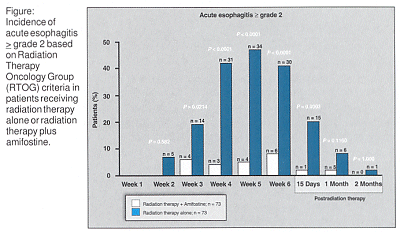Amifostine Reduces Side Effects During Treatment for Advanced Lung Cancer
PIREAUS, Greece-In advanced-stage lung cancer, radiation therapy provides effective local-regional control but requires irradiation of large tissue volumes and high total tumor doses. "Bolus tumor doses higher than 60 Gy produce better local tumor control but more toxicity," Dosia Antonadou, MD, explained.
PIREAUS, GreeceIn advanced-stage lung cancer, radiation therapy provides effective local-regional control but requires irradiation of large tissue volumes and high total tumor doses. "Bolus tumor doses higher than 60 Gy produce better local tumor control but more toxicity," Dosia Antonadou, MD, explained.
"Patients with lung cancer have compromised lung tissue and they can have many symptoms during or after radiation therapy or during radiochemotherapy," she continued. "We undertook a phase III randomized, multicenter trial to investigate whether daily pretreatment with amifostine (Ethyol) could safely reduce the incidence of esophagitis and pneumonitis in patients with lung cancer undergoing definitive conventional radiotherapy." Dr. Antonadou is consultant in the Radiation Oncology Department, Metaxas Cancer Hospital, Pireaus, Greece.
Patients were randomized to either 340 mg/m² IV amifostine, given daily 15 to 20 minutes before radiation, followed by radiation at 2 Gy/day, 5 days per week, to a total dose of 55 to 60 Gy, or to the same regimen without amifostine.
The primary study endpoints were the incidence of grade 2 or worse esophagitis, the incidence of grade 2 or worse acute lung toxicity, and the incidence of pneumonitis and/or fibrosis. Secondary endpoints were response rates. "This was to address the concern that amifostine might compromise the efficacy of the treatment," Dr. Antonadou said.
Patients entered into this study had histologically or cytologically proven lung cancer with a performance status of 2 or better and disease confined to the primary sites and regional lymph nodes. Patients with pleural effusion were excluded from the study. No previous radiotherapy was allowed.
Dr. Antonadou reported that 146 patients were randomized, that median follow up was 5 months, and that the treatment arms were evenly balanced. "The majority of our patients were stage IIIB," she said.
Esophagitis Resolved
"After week 3 we observed a significant reduction in acute esophagitis in patients who received amifostine," Dr. Antonadou said. "This difference increased during subsequent weeks." Esophagitis also resolved more quickly in the amifostine-treated patients. Acute pulmonary toxicity was also significantly lower in the patients treated with amifostine.

"With regard to pneumonitis, within the first month of treatment we saw a difference between the two groups, and this became statistically significant by the beginning of the second month," Dr. Antonadou said.
Radiological evaluation by computed tomography (CT) scan confirmed this finding. CT findings of fibrosis included homogeneous increased opacity, nonhomogeneous increased opacity, changes that cross anatomic boundaries, loss of lung volume, pleural thickening, pleural effusion, haziness of pulmonary markings, and poorly defined edges. The incidence of fibrosis at 6 months was 28% in amifostine-treated patients vs 53% in patients who did not receive amifostine (P < 0.05).
No Adverse Effect on Response to Radiation
Of the 146 patients entered in this trial, 97 were evaluable for response.
"Amifostine was given daily. In only one case we had to discontinue the amifostine administration. We didn’t have any major cases of nausea or vomiting or hypotension, and we did not give any oral fluids," Dr. Antonadou said. "Amifostine significantly reduced esophagitis, reduced late lung toxicity, reduced the clinical symptoms such as dyspnea and cough, and reduced the incidence of pneumonitis and fibrosis. There was no evidence of compromised treatment efficacy, and we concluded that daily doses of amifostine are well tolerated."
A subsequent pilot study involved induction chemotherapy followed by radiotherapy with or without amifostine in patients with advanced lung cancer. "There were 22 patients in the amifostine group and 23 patients in the control group. This included both non-small-cell lung cancer and small-cell lung cancer patients, and all were heavily pretreated with cisplatin (Platinol)-based chemotherapy. We would expect symptoms of esophagitis during the third to fifth week in such patients. In this small study there was a significant reduction in esophagitis in patients treated with amifostine. The same thing was observed for pneumonitis and for fibrosis. Amifostine significantly reduced acute and late toxicities in chemotherapy-pretreated patients," Dr. Antonadou said.
Neoadjuvant Capecitabine Plus Temozolomide in Atypical Lung NETs
Read about a woman with well-differentiated atypical carcinoid who experienced a 21% regression in primary tumor size after 12 months on neoadjuvant capecitabine and temozolomide.